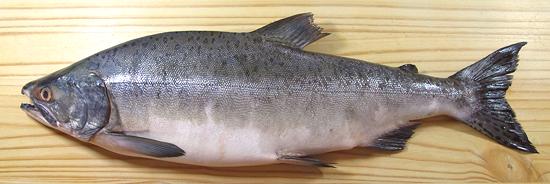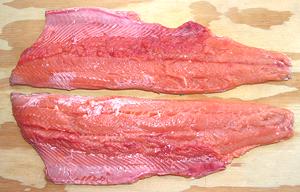Pink Salmon
 [Humpy, Hump Back; Oncorhynchus gorbuscha]
[Humpy, Hump Back; Oncorhynchus gorbuscha]
This is the smallest, and most numerous, of the Wild Salmon. It inhabits
the Arctic Ocean from above western Canada, Alaska and eastern Siberia.
It is most numerous on the south side of Alaska, and extends down to
Korea in Asia, and the Sacramento River in California, and sometimes
farther south. They were accidently introduced to the American Great
Lakes, and have established populations there.
Aside from commercial
catch, these fish are a very popular for sports fishing. The record
weight is 15 pounds, but they are normally about 20 inches and a little
under 4 pounds. The photo specimen, a nearly ready to spawn male,
wild caught in Canada, was 22 inches long and weighed 4 pounds 3 ounces.
These salmon live only two years, spawning and dieing in their second
year. They are caught mainly during their spawning period (July to
September) when they return from the sea to fresh water. There are odd
and even year populations. Sometimes Pink Salmon cross breed with
Chum Salmon (Oncorhynchus keta), producing sterile hybrids called
Miko Salmon.
More on Varieties of Fish
(very large page).
The flesh of Pink Salmon is lighter than larger salmon, tender and
delicate, with a lot less oil. It holds together well for any method of
cooking. When poached it flakes apart easily at the table into moderately
thick flakes. When pan fried, it more breaks apart rather than flaking,
but still does so easily. It is less suitable for grilling than fattier
salmon. The skin can be left on for any method of cooking. Color will
vary with the fish's diet, and has no effect on flavor or quality.
Buying: I have found whole fish in one of the Philippine
markets here in Los Angles (Eagle Rock). The photo specimen was 22
inches long and weighed 4 pounds 3 ounces. It was purchased in late
August for 2019 US $2.99 per pound, wild caught in Canada. You will
find only males in the market - the females have been harvested of
their eggs, then sold as fillets. Only the males get a hump back when
ready to spawn.
Scales: The scales are tiny, soft and thin, scraping off
almost as a gray slush. I have found it more effective to shave them off
with the sharp edge of my prep knife rather than scraping in the usual
manner.
Cleaning: Nothing particularly difficult here except
the length of the body cavity. There is a long membrane that has to be
broken through and scraped out, along with the blood works between it
and the backbone. The gills pull a bit hard and tend to break up, but
since you're unlikely to cook this fish head-on, you might as well
remove it right away, dipping the knife under the collar to get the
most flesh.
Ribs: Once you have the fish cleaned, the body cavity
will open up wide. The ribs are many, thread thin, and long, but they
are very easy to find and remove. With long nose pliers, just give them
a little twist to break them from the backbone and pull
them out. They will give little resistance.
 Fillet: Except for the size, this is not a difficult
fish to fillet in the usual manner. When you jump over the backbone at
the tail and work forward, when you get to the body cavity, the ribs
have already been removed, so just cut the fillet away from the
backbone. Now for the bad news. There is a row of pinbones for the
first 2/3s of the fish. You can see them as tiny white dots on the
fillet. They are a good inch long and almost horizontal pointed toward
the tail. Fortunately, they are easy to find and pull straight forward
very easily, taking no flesh.
Fillet: Except for the size, this is not a difficult
fish to fillet in the usual manner. When you jump over the backbone at
the tail and work forward, when you get to the body cavity, the ribs
have already been removed, so just cut the fillet away from the
backbone. Now for the bad news. There is a row of pinbones for the
first 2/3s of the fish. You can see them as tiny white dots on the
fillet. They are a good inch long and almost horizontal pointed toward
the tail. Fortunately, they are easy to find and pull straight forward
very easily, taking no flesh.
Skin: The skin has a more intense flavor than the
flesh, but is not at all offensive. It has very little shrink, so pieces
of fillet can be pan fried or poached skin-on with little or no
distortion, much like Rainbow Trout. While there is little need to
remove the skin, it is easily removed using the long knife and cutting
board Method. It is thin, but
strong, and can be removed with very little loss of flesh.
Yield: A 4 pound 2 ounce fish yielded 2 pounds 7 ounces
of skin-on fillet (66%), very high for a fish. Skin-off that would be
about 2 pounds 2-1/4 ounces (52%), still decent yield.
Stock: The head, bones and fins made a lightly flavored
stock, almost clear with no salmon coloration. There will be quite a bit
of oil, which you need to remove - use your gravy separator. See our
recipe Making Fish Stock for
method, and how to store it.
Health & Nutrition: Pink salmon is high in long
chain omega 3 fatty acids, EPA and DHA.
sf_salmpkz 082819 - www.clovegarden.com
©Andrew Grygus - agryg@clovegarden.com - Photos
on this page not otherwise credited © cg1
- Linking to and non-commercial use of this page permitted
 Fillet: Except for the size, this is not a difficult
fish to fillet in the usual manner. When you jump over the backbone at
the tail and work forward, when you get to the body cavity, the ribs
have already been removed, so just cut the fillet away from the
backbone. Now for the bad news. There is a row of pinbones for the
first 2/3s of the fish. You can see them as tiny white dots on the
fillet. They are a good inch long and almost horizontal pointed toward
the tail. Fortunately, they are easy to find and pull straight forward
very easily, taking no flesh.
Fillet: Except for the size, this is not a difficult
fish to fillet in the usual manner. When you jump over the backbone at
the tail and work forward, when you get to the body cavity, the ribs
have already been removed, so just cut the fillet away from the
backbone. Now for the bad news. There is a row of pinbones for the
first 2/3s of the fish. You can see them as tiny white dots on the
fillet. They are a good inch long and almost horizontal pointed toward
the tail. Fortunately, they are easy to find and pull straight forward
very easily, taking no flesh. [Humpy, Hump Back; Oncorhynchus gorbuscha]
[Humpy, Hump Back; Oncorhynchus gorbuscha]